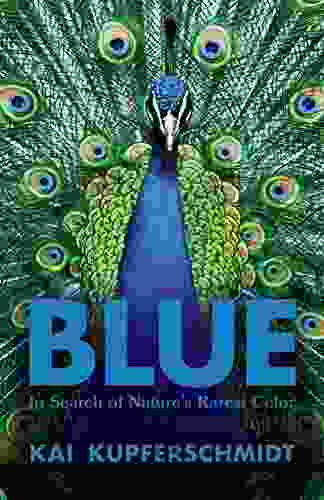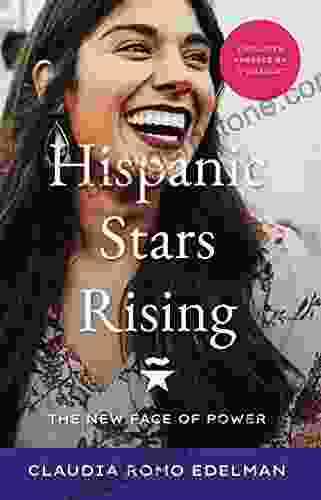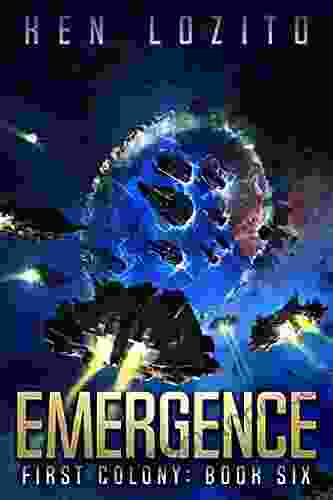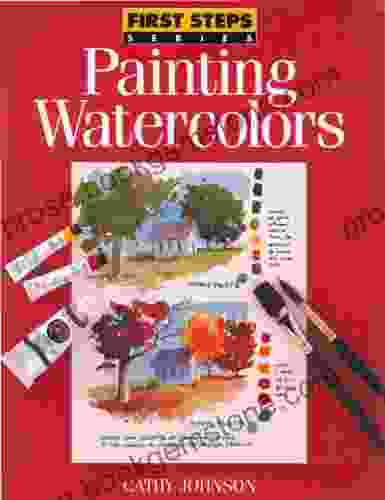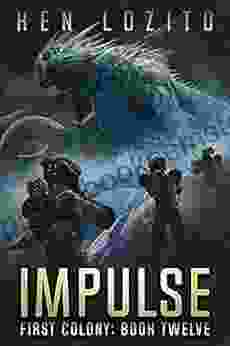Blue In Search Of Nature Rarest Color

In the vast and kaleidoscopic canvas of nature, there exists a hue that stands out with its enigmatic beauty and elusive presence. Blue, a color often associated with serenity, tranquility, and the boundless expanse of the sky and sea, is a captivating shade that has captivated human imagination for centuries.
4.8 out of 5
| Language | : | English |
| File size | : | 37051 KB |
| Text-to-Speech | : | Enabled |
| Screen Reader | : | Supported |
| Enhanced typesetting | : | Enabled |
| X-Ray | : | Enabled |
| Word Wise | : | Enabled |
| Print length | : | 220 pages |
| Lending | : | Enabled |
However, despite its ubiquity in the human realm, blue is a surprisingly rare color in the natural world. While the spectrum of colors we perceive is vast, true blue pigments are remarkably scarce in the plant and animal kingdoms. This scarcity has led to a fascinating paradox: blue, a color that evokes feelings of vastness and infinity, is in reality one of nature's most elusive hues.
Unveiling the Reasons for Blue's Rarity
The underlying reasons for the rarity of blue in nature are rooted in the fundamental principles of physics and chemistry. The perception of color is a complex process that involves the interaction of light with matter. When light strikes an object, some wavelengths are absorbed, while others are reflected. The reflected wavelengths determine the color we perceive.
In the case of blue, its scarcity can be attributed to the fact that the molecules in most natural objects absorb blue wavelengths more readily than other colors. This absorption is due to the electronic structure of these molecules. The energy difference between the ground state and the excited state of the electrons in these molecules corresponds to the energy of blue light. As a result, blue light is more likely to be absorbed than reflected, leading to the scarcity of blue pigments in nature.
Nature's Ingenious Ways of Creating Blue
Despite its rarity, nature has evolved ingenious mechanisms to produce blue hues in certain organisms. These mechanisms, while uncommon, demonstrate the remarkable diversity and adaptability of life on Earth.
One of the most fascinating examples of nature's blue-producing prowess is the structural coloration found in the wings of butterflies and feathers of certain birds. In these structures, microscopic arrays of tiny scales or feathers act as a diffraction grating, selectively reflecting blue wavelengths while canceling out other colors. This phenomenon, known as Rayleigh scattering, is the same principle that gives the sky its blue appearance.
Another mechanism employed by nature to create blue is the presence of certain pigments, such as biliverdin and phycocyanin. Biliverdin is a green pigment that, when combined with other molecules, can produce blue-green hues. It is found in the bile of vertebrates and is responsible for the bluish-green color of some bruises. Phycocyanin, on the other hand, is a blue pigment found in certain types of algae and cyanobacteria. It is responsible for the characteristic blue-green color of spirulina, a popular health food supplement.
The Cultural Significance of Blue
Throughout history, blue has held a profound cultural significance across diverse civilizations. In ancient Egypt, the color was associated with the goddess Isis and was often used in religious ceremonies and artwork. In China, blue was considered a sacred color, symbolizing heaven and immortality. In Japan, the color indigo, a deep shade of blue, was highly valued for its use in traditional dyeing techniques.
In Western culture, blue has been associated with royalty and nobility since the Middle Ages. The deep blue pigment known as ultramarine was highly prized and used in the creation of exquisite works of art, including religious paintings and royal tapestries. The color blue continues to be a popular choice for clothing, home décor, and design, evoking a sense of elegance, sophistication, and tranquility.
Stories and Legends Surrounding Blue
The enigmatic nature of blue has inspired numerous stories and legends throughout history. In many cultures, blue is associated with the supernatural and the divine. In Celtic folklore, the blue flower is said to possess magical properties and is believed to bring good luck and protection. In Christian tradition, the Virgin Mary is often depicted wearing a blue robe, symbolizing her purity and heavenly grace.
One of the most enduring legends surrounding blue is the story of the Blue Bird of Happiness. This mythical bird is said to bring joy and fulfillment to those who catch a glimpse of it. The legend has been immortalized in plays, songs, and even a popular children's book.
Blue, a color that evokes feelings of vastness, serenity, and wonder, is a true enigma in the natural world. Its rarity, coupled with its profound cultural and symbolic significance, makes it a captivating subject of exploration. As we continue to unravel the secrets of nature's rarest color, we deepen our appreciation for the intricate tapestry of life on Earth and the boundless beauty that surrounds us.
So, let us continue to gaze up at the sapphire skies, marvel at the azure hues of distant horizons, and seek out the hidden blues that nature has to offer. For in the elusive embrace of this enchanting color, we find a reminder of the wonders that lie just beyond our grasp, waiting to be discovered.
4.8 out of 5
| Language | : | English |
| File size | : | 37051 KB |
| Text-to-Speech | : | Enabled |
| Screen Reader | : | Supported |
| Enhanced typesetting | : | Enabled |
| X-Ray | : | Enabled |
| Word Wise | : | Enabled |
| Print length | : | 220 pages |
| Lending | : | Enabled |
Do you want to contribute by writing guest posts on this blog?
Please contact us and send us a resume of previous articles that you have written.
 Best Book
Best Book Page Flip
Page Flip Bookshelf
Bookshelf Literary loom
Literary loom Chapter
Chapter Bookish
Bookish PageTurner
PageTurner Bibliophile
Bibliophile Story
Story Inkwell
Inkwell Bookworm
Bookworm Labyrinth
Labyrinth Plot Twist
Plot Twist Prose
Prose Paperback
Paperback Storyteller
Storyteller Sanctuary
Sanctuary Fiction
Fiction Reading
Reading Chronicle
Chronicle Read
Read George Alec Effinger
George Alec Effinger C Carr
C Carr Paul Reps
Paul Reps Carolyn Han
Carolyn Han C B Griesbach
C B Griesbach Lacy Crawford
Lacy Crawford Keisha J
Keisha J Brandon Massey
Brandon Massey Marji Hill
Marji Hill Shane Lochlann Black
Shane Lochlann Black Timon Screech
Timon Screech Lauren Kessler
Lauren Kessler Jason Anspach
Jason Anspach Howard Beckerman
Howard Beckerman Jared Blando
Jared Blando Jennifer Niven
Jennifer Niven Catherine Gill
Catherine Gill Bruce Ansley
Bruce Ansley J T Skye
J T Skye Bruce Spydar
Bruce Spydar Darla Mayberry
Darla Mayberry Brian Dougherty
Brian Dougherty John Berger
John Berger Janice Seto
Janice Seto Sallust
Sallust Ken Lozito
Ken Lozito Tiffanie Didonato
Tiffanie Didonato Jennifer Smith Turner
Jennifer Smith Turner Marcos Enrique Ruiz Rivero Ii Aviel
Marcos Enrique Ruiz Rivero Ii Aviel Nate Crowley
Nate Crowley Robert L Forward
Robert L Forward Graham Mackintosh
Graham Mackintosh Dennis Tupicoff
Dennis Tupicoff Camille Laurens
Camille Laurens Gabriel Weisz Carrington
Gabriel Weisz Carrington Caitlin Starling
Caitlin Starling Clayton Graham
Clayton Graham Brian Smith
Brian Smith Jillian Vose
Jillian Vose Sterling Edwards
Sterling Edwards Tom Wolfe
Tom Wolfe Kathleen Mccormack
Kathleen Mccormack John Wagner
John Wagner Lincoln Child
Lincoln Child Isa Milman
Isa Milman Caroline Weber
Caroline Weber Jacques Vankirk
Jacques Vankirk Bruce T Batchelor
Bruce T Batchelor Rodolphe Lasnes
Rodolphe Lasnes Sven Lindqvist
Sven Lindqvist Wilder Page
Wilder Page Oliver La Farge
Oliver La Farge Brady J Crytzer
Brady J Crytzer Kate Fullagar
Kate Fullagar Craig Anderson
Craig Anderson Dean Foster
Dean Foster Carole Massey
Carole Massey Russell Harris
Russell Harris Keith Mccloskey
Keith Mccloskey Carlos Francisco Jackson
Carlos Francisco Jackson Susan Hill
Susan Hill Inc Complex Media
Inc Complex Media Sara Rudin
Sara Rudin Deborah Ball
Deborah Ball John Clites
John Clites Caren Schnur Neile
Caren Schnur Neile John Waters
John Waters Rafael De Grenade
Rafael De Grenade Dawn Prince Hughes
Dawn Prince Hughes Dl Acken
Dl Acken C J Cherryh
C J Cherryh Caroline Self
Caroline Self Jesse Leon
Jesse Leon Niobia Bryant
Niobia Bryant Lidia Bastianich
Lidia Bastianich Kellee Wynne Conrad
Kellee Wynne Conrad K Wan
K Wan Sabeeha Rehman
Sabeeha Rehman Mynor Schult
Mynor Schult Burton Bernstein
Burton Bernstein Danielle Bernstein
Danielle Bernstein Justin Spizman
Justin Spizman Joshua Slocum
Joshua Slocum M R Forbes
M R Forbes Nick Caistor
Nick Caistor Peter Cawdron
Peter Cawdron Carolyn Porter
Carolyn Porter Murry E Page
Murry E Page Caitlyn O Leary
Caitlyn O Leary Capt Ron Nielsen
Capt Ron Nielsen N K Jemisin
N K Jemisin Paul Chiasson
Paul Chiasson Cathy Johnson
Cathy Johnson Luca Somigli
Luca Somigli Ilhan Omar
Ilhan Omar Kelsey Oseid
Kelsey Oseid Donald Keene
Donald Keene Jill Winch
Jill Winch Bell Hooks
Bell Hooks Eve Laplante
Eve Laplante Dianne Hales
Dianne Hales Bev Sellars
Bev Sellars Lonely Planet
Lonely Planet Jennifer Julie Miller
Jennifer Julie Miller Robert Littell
Robert Littell W E B Du Bois
W E B Du Bois Vrasidas Karalis
Vrasidas Karalis Michelle Kuo
Michelle Kuo Marcia Iwatate
Marcia Iwatate Sonia Cheadle
Sonia Cheadle Relaxed Venues
Relaxed Venues Elayne Silva Reyna
Elayne Silva Reyna Cathie Ruggie Saunders
Cathie Ruggie Saunders Mary Stuart
Mary Stuart Kirsten Pai Buick
Kirsten Pai Buick Susan Kennedy
Susan Kennedy Carrol L Henderson
Carrol L Henderson Russell Maddicks
Russell Maddicks Dessy Tsolova
Dessy Tsolova Sarah Spencer
Sarah Spencer Renee Rose
Renee Rose Liron Yanconsky
Liron Yanconsky Brooke Hayward
Brooke Hayward Brooke Barbier
Brooke Barbier Dana Mahan Jr
Dana Mahan Jr Robert Lamouroux
Robert Lamouroux Carolyn Brown
Carolyn Brown Niall Williams
Niall Williams Candy Moore
Candy Moore Charlene Mciver
Charlene Mciver Paul E Fallon
Paul E Fallon Lincoln Cushing
Lincoln Cushing H Peter Alesso
H Peter Alesso Perry Buck
Perry Buck Carl Hiaasen
Carl Hiaasen Bruce Baird
Bruce Baird C S Leaf
C S Leaf Meena Alexander
Meena Alexander Marceline Smith
Marceline Smith D L Young
D L Young Guy Haley
Guy Haley Cassie Dandridge Selleck
Cassie Dandridge Selleck Troy Howarth
Troy Howarth Terry Galloway
Terry Galloway Dwayne Walker
Dwayne Walker John Campbell
John Campbell Kris Timken
Kris Timken Dan Moren
Dan Moren Jay Wolf
Jay Wolf James N Yamazaki
James N Yamazaki Peter Moruzzi
Peter Moruzzi Burst Books
Burst Books Tim Jeal
Tim Jeal Daphne Jenkins Sheldrick
Daphne Jenkins Sheldrick Bill Plympton
Bill Plympton Carole Zucker
Carole Zucker Gary Chandler
Gary Chandler Daniel Arenson
Daniel Arenson Gene H Bell Villada
Gene H Bell Villada Mineko Iwasaki
Mineko Iwasaki Greg Keyes
Greg Keyes David Kalat
David Kalat Tao Wong
Tao Wong Frances Mayes
Frances Mayes D Dauphinee
D Dauphinee Carolyn J Brown
Carolyn J Brown Elsa Sjunneson
Elsa Sjunneson Jason Diamond
Jason Diamond Ella Maven
Ella Maven Mike Jack Stoumbos
Mike Jack Stoumbos Carole Robson
Carole Robson Herbie J Pilato
Herbie J Pilato Noell K Wolfgram Evans
Noell K Wolfgram Evans Leanne Howe
Leanne Howe Peter Mutabazi
Peter Mutabazi K G Crawford
K G Crawford Mz Creates
Mz Creates Eric Henze
Eric Henze Whitney Crothers Dilley
Whitney Crothers Dilley Robert Egan
Robert Egan Scott Hughey
Scott Hughey Mimi Robinson
Mimi Robinson Veronica Lawlor
Veronica Lawlor Carol Berry
Carol Berry Haytham Al Fiqi
Haytham Al Fiqi Brian Harker
Brian Harker Mark Allen
Mark Allen Leo Buijs
Leo Buijs David L Sloan
David L Sloan The Editors Of New York Magazine
The Editors Of New York Magazine Heriberto Padilla
Heriberto Padilla Charles Earl Bradbury
Charles Earl Bradbury Lisa Colozza Cocca
Lisa Colozza Cocca Vladimir Geroimenko
Vladimir Geroimenko Paul Smith
Paul Smith Terrence K Williams
Terrence K Williams Carrie Cariello
Carrie Cariello Carol Wood
Carol Wood Sean Adams
Sean Adams Robert Barr Smith
Robert Barr Smith Kai Kupferschmidt
Kai Kupferschmidt George R R Martin
George R R Martin Sara Alm
Sara Alm Robin Hobb
Robin Hobb J R Grey
J R Grey Chris Willis
Chris Willis Drmw
Drmw Vaughn Heppner
Vaughn Heppner Parshwika Bhandari
Parshwika Bhandari Margarida Araya
Margarida Araya Emiko Yamamoto
Emiko Yamamoto Mia Black
Mia Black Brian Lawrenson
Brian Lawrenson Carol A Krejci
Carol A Krejci Stephen Kohler
Stephen Kohler S C Eston
S C Eston Mara Jaye
Mara Jaye Scott David Plumlee
Scott David Plumlee Sudhir Hazareesingh
Sudhir Hazareesingh J A Fielding
J A Fielding Edgardo Cozarinsky
Edgardo Cozarinsky Kate Furnivall
Kate Furnivall Jenny Lawson
Jenny Lawson Carrie Summers
Carrie Summers Max Vance
Max Vance Hugh Leach
Hugh Leach Polly Evans
Polly Evans Karyn Langhorne Folan
Karyn Langhorne Folan Brian Evans
Brian Evans Ednor Therriault
Ednor Therriault Kimi Cunningham Grant
Kimi Cunningham Grant Mary C Olson
Mary C Olson Ian Olio
Ian Olio Zitkala Sa
Zitkala Sa Mark Wandrey
Mark Wandrey Tom Segev
Tom Segev David Ryan
David Ryan Constantin Step
Constantin Step Catherine Craft
Catherine Craft Tony Bartelme
Tony Bartelme Eric Bravo
Eric Bravo Byron Comstock
Byron Comstock Briar Levit
Briar Levit Brette Sember
Brette Sember Suzette D Harrison
Suzette D Harrison Victoria Smith
Victoria Smith Mark Greenside
Mark Greenside Jane Urquhart
Jane Urquhart Kelly Sheldrick
Kelly Sheldrick Walter Mosley
Walter Mosley Sharon C Cooper
Sharon C Cooper Bridget Quinn
Bridget Quinn Brenda Jackson
Brenda Jackson Ben Box
Ben Box Carrie Fisher
Carrie Fisher Remco Ensel
Remco Ensel Joan See
Joan See Marge Piercy
Marge Piercy Dolly Parton
Dolly Parton Brittney Brooke
Brittney Brooke Bwwm Love
Bwwm Love James Steffen
James Steffen Caroline Scott
Caroline Scott Kateri Ewing
Kateri Ewing Mario Puzo
Mario Puzo David Gilmore
David Gilmore Maud Guilfoyle
Maud Guilfoyle Reyna Grande
Reyna Grande Carolina Rose
Carolina Rose Tanya Lapointe
Tanya Lapointe Lily Koppel
Lily Koppel Brandi Rarus
Brandi Rarus Paul Clammer
Paul Clammer Maturin Murray Ballou
Maturin Murray Ballou Linda Grant
Linda Grant Gerald S Strober
Gerald S Strober Richard Mayhew
Richard Mayhew Scott Finazzo
Scott Finazzo Rosalind Rosenberg
Rosalind Rosenberg Butch Hartman
Butch Hartman Carmen Reid
Carmen Reid Brian Broome
Brian Broome Carsten Wieland
Carsten Wieland J C Moore
J C Moore Tara M Stringfellow
Tara M Stringfellow William Hogarth
William Hogarth Jennine Capo Crucet
Jennine Capo Crucet Carole S Kessner
Carole S Kessner Maurice Broaddus
Maurice Broaddus Brittany K Barnett
Brittany K Barnett Milo James Fowler
Milo James Fowler Michael Jacobs
Michael Jacobs John Muir
John Muir J F Martel
J F Martel Elise Young
Elise Young Tim Hannigan
Tim Hannigan Gretchen Rubin
Gretchen Rubin D B Goodin
D B Goodin Tosha Lavette
Tosha Lavette Maria Holderbaum
Maria Holderbaum Judith Heumann
Judith Heumann Diana Somerville
Diana Somerville Jenny Volvovski
Jenny Volvovski David Crow
David Crow Vicki Zoradi
Vicki Zoradi Miles J Unger
Miles J Unger Michael Hingson
Michael Hingson Jeffrey Ross
Jeffrey Ross Ramin Zahed
Ramin Zahed Scott D Smith
Scott D Smith James Mcbride
James Mcbride Bradford Pearson
Bradford Pearson Mindy Lighthipe
Mindy Lighthipe Christy Brown
Christy Brown Tj Silverlake
Tj Silverlake Ken Steele
Ken Steele Carol Miller
Carol Miller Josh Malerman
Josh Malerman Timothy Zahn
Timothy Zahn Parvati Sharma
Parvati Sharma Matt Brown
Matt Brown Delaney Diamond
Delaney Diamond Brendan Keogh
Brendan Keogh Ernesto Mallo
Ernesto Mallo William Matson
William Matson C H Duryea
C H Duryea Michael Frary
Michael Frary D J Conway
D J Conway Rachel Felder
Rachel Felder Peggy Dean
Peggy Dean Mandy Pattullo
Mandy Pattullo C T Rwizi
C T Rwizi Frederick Joseph
Frederick Joseph Booker T Washington
Booker T Washington Donna Digiuseppe
Donna Digiuseppe C V Walter
C V Walter Jonathan Raban
Jonathan Raban Scaachi Koul
Scaachi Koul Brooke Rundle
Brooke Rundle Brian D Meeks
Brian D Meeks Greater Than A Tourist
Greater Than A Tourist Michael Sragow
Michael Sragow Stuart Kendall
Stuart Kendall Tod Polson
Tod Polson Dave Walsh
Dave Walsh Gaston Migeon
Gaston Migeon Marilyn Ann Moss
Marilyn Ann Moss Kevin Winkler
Kevin Winkler Griff Hosker
Griff Hosker Toni Bentley
Toni Bentley Gary Gibson
Gary Gibson Caroline Johnson
Caroline Johnson Claudia Romo Edelman
Claudia Romo Edelman Marie Arana
Marie Arana Brenda Ferguson Hodges
Brenda Ferguson Hodges Mark Dawson
Mark Dawson Bradford Bates
Bradford Bates C Shortt
C Shortt Lyn Wilkerson
Lyn Wilkerson Katie Douglas
Katie Douglas Yuwanda Black
Yuwanda Black Victor Manibo
Victor Manibo Peter Rhee
Peter Rhee Carly Murden
Carly Murden Daniel J Sharfstein
Daniel J Sharfstein Eric Grzymkowski
Eric Grzymkowski Gretchen M Baker
Gretchen M Baker Cale Plamann
Cale Plamann Brian Borgford
Brian Borgford Breeze Holding The Moon
Breeze Holding The Moon Nate Staniforth
Nate Staniforth Howard Schultz
Howard Schultz Mira Jacob
Mira Jacob C J Box
C J Box Camelia Elias
Camelia Elias Mark Lewis
Mark Lewis Mikhail Uspensky
Mikhail Uspensky Tom Bergeron
Tom Bergeron Tanith Lee
Tanith Lee Bob Elliott
Bob Elliott Joe R Frinzi
Joe R Frinzi Carol Belanger Grafton
Carol Belanger Grafton Stephen Mertz
Stephen Mertz Simon Loxley
Simon Loxley Wayne Mardle
Wayne Mardle Emiko Ohnuki Tierney
Emiko Ohnuki Tierney Robbie Freeman Shugart
Robbie Freeman Shugart Catherine Porter
Catherine Porter Jack Vance
Jack Vance Cain Carroll
Cain Carroll Brit Bennett
Brit Bennett Michelle Burford
Michelle Burford C White Foss
C White Foss Kate Schelter
Kate Schelter Eddie Jaku
Eddie Jaku David Gerrold
David Gerrold Jack L Roberts
Jack L Roberts Carolyn Birrell
Carolyn Birrell S J A Turney
S J A Turney Kay Bratt
Kay Bratt Jerry Remy
Jerry Remy Dave Pelzer
Dave Pelzer Bridget Conor
Bridget Conor Janet Whittle
Janet Whittle Buie Harwood
Buie Harwood Caterine Milinaire
Caterine Milinaire Julia Sherman
Julia Sherman June Foray
June Foray Charles Kenney
Charles Kenney C M Carney
C M Carney Kellie Stafford
Kellie Stafford Yumiko Alexander
Yumiko Alexander Tasha Black
Tasha Black Maya Jasanoff
Maya Jasanoff Mike Lyon
Mike Lyon Mateus Batista
Mateus Batista Rabbi Lynnda Targan
Rabbi Lynnda Targan Bruce Sutherland
Bruce Sutherland Elin Hilderbrand
Elin Hilderbrand Erik Stafford
Erik Stafford Brad Leone
Brad Leone Darin Martineau
Darin Martineau Eric Shanes
Eric Shanes Brian Seibert
Brian Seibert Devon C Ford
Devon C Ford Carole Angier
Carole Angier Lynn Gilbert
Lynn Gilbert Pearl S Buck
Pearl S Buck Norberto Chaves
Norberto Chaves Mark Arnold
Mark Arnold Brian C Hailes
Brian C Hailes C Gockel
C Gockel Brian Hicks
Brian Hicks Michael Bierut
Michael Bierut Bruce Kennett
Bruce Kennett Jan Grue
Jan Grue Michael Lent
Michael Lent Lucy R Lippard
Lucy R Lippard Madeleine L Engle
Madeleine L Engle Sheri S Tepper
Sheri S Tepper Tad Crawford
Tad Crawford Lee Hammond
Lee Hammond John Logan
John Logan Shaku Atre
Shaku Atre Casey Diaz
Casey Diaz Iris Scott
Iris Scott Gail Grant
Gail Grant Brontez Purnell
Brontez Purnell James Tate Hill
James Tate Hill Michael Moon
Michael Moon Liane Grunberg Wakabayashi
Liane Grunberg Wakabayashi Olivia Riley
Olivia Riley Pyae Moe Thet War
Pyae Moe Thet War Connie Fleenor
Connie Fleenor Zora Neale Hurston
Zora Neale Hurston Brandon Q Morris
Brandon Q Morris Kamal Saleem
Kamal Saleem Brian Herbert
Brian Herbert Mike Watt
Mike Watt Joe Palermo
Joe Palermo Cheryl Burke
Cheryl Burke Linda Przybyszewski
Linda Przybyszewski Nicolas Rothwell
Nicolas Rothwell R Annie Gough
R Annie Gough Janice Oberding
Janice Oberding Johnnie Gentle
Johnnie Gentle Sarah Garland
Sarah Garland Catherine Kerrison
Catherine Kerrison Virginia Hein
Virginia Hein Sarah Jane Downing
Sarah Jane Downing Lisa Fenn
Lisa Fenn Carlyn Beccia
Carlyn Beccia Jennie Batchelor
Jennie Batchelor Eufrasia Gagliardo
Eufrasia Gagliardo David Steffen
David Steffen David H Levy
David H Levy Kimberlee Yolanda Williams
Kimberlee Yolanda Williams Magnus Reid
Magnus Reid Nikqua
Nikqua Gerald M Kilby
Gerald M Kilby Steven V Roberts
Steven V Roberts Peter Razor
Peter Razor James O Reilly
James O Reilly Joel Shepherd
Joel Shepherd Bob Able
Bob Able Carter Hasegawa
Carter Hasegawa Laylah Roberts
Laylah Roberts S K Dunstall
S K Dunstall Roberto Sandorez
Roberto Sandorez Vanessa Riley
Vanessa Riley Brendan Nuenfeldt
Brendan Nuenfeldt Shaun King
Shaun King Jasmine Tritten Llc
Jasmine Tritten Llc Robert Noble Graham
Robert Noble Graham Bryon Macwilliams
Bryon Macwilliams Olivia De Havilland
Olivia De Havilland Karma Waltonen
Karma Waltonen Francene Hart
Francene Hart Caroline Knapp
Caroline Knapp Brian Ladd
Brian Ladd Brian Ashcraft
Brian Ashcraft Bryce W James
Bryce W James James Graham Baker
James Graham Baker Tom Hayden
Tom Hayden Eric Walters
Eric Walters Ems Publishing
Ems Publishing Tananarive Due
Tananarive Due Melissa R Klapper
Melissa R Klapper Emily Sturgill
Emily Sturgill Jenifer Ringer
Jenifer Ringer Caseen Gaines
Caseen Gaines Toni Braxton
Toni Braxton Carol Bolt
Carol Bolt Brien Foerster
Brien Foerster Leigh Ann Gale
Leigh Ann Gale Carl Weber
Carl Weber Shirish Deshpande
Shirish Deshpande Bryan Miles
Bryan Miles Foundation Of Flexographic Technical...
Foundation Of Flexographic Technical... Rachael Lynn
Rachael Lynn Carolyn Schulz
Carolyn Schulz Carla L Peterson
Carla L Peterson Karl Fulves
Karl Fulves Camilla Erickson
Camilla Erickson Chronicle Books
Chronicle Books Brian Wright Mcleod
Brian Wright Mcleod Cal Patch
Cal Patch Bruce Schoenfeld
Bruce Schoenfeld Mark Leonard
Mark Leonard Yolanda Hadid
Yolanda Hadid Pete Dunne
Pete Dunne Carl E Schorske
Carl E Schorske Sandy Allison
Sandy Allison Robin Capon
Robin Capon Brittney C Cooper
Brittney C Cooper Suzanne Woods Fisher
Suzanne Woods Fisher Dan X Solo
Dan X Solo Brando Skyhorse
Brando Skyhorse Cat Seto
Cat Seto Carmen Sheldon
Carmen Sheldon Kelly Kordes Anton
Kelly Kordes Anton Rick Cheadle
Rick Cheadle Taniece
Taniece Didier Ghez
Didier Ghez Camilla Townsend
Camilla Townsend Laila Ibrahim
Laila Ibrahim Brian Seidman
Brian Seidman Sister Dang Nghiem
Sister Dang Nghiem Thomas Kinkade
Thomas Kinkade Kevina Hopkins
Kevina Hopkins Mike Gayle
Mike Gayle Brandon Webb
Brandon Webb William T Vollmann
William T Vollmann Rheni Tauchid
Rheni Tauchid David Sayers
David Sayers Jake Jackson
Jake Jackson Stephanie Elizondo Griest
Stephanie Elizondo Griest Brian Dickinson
Brian Dickinson G L Carriger
G L Carriger Catherynne M Valente
Catherynne M Valente Joe Ide
Joe Ide Kimolisa Mings
Kimolisa Mings Bruce Bradley
Bruce Bradley Brian C Baer
Brian C Baer Tamar Arslanian
Tamar Arslanian Vladimir Sorokin
Vladimir Sorokin Thomas S Abler
Thomas S Abler
Light bulbAdvertise smarter! Our strategic ad space ensures maximum exposure. Reserve your spot today!
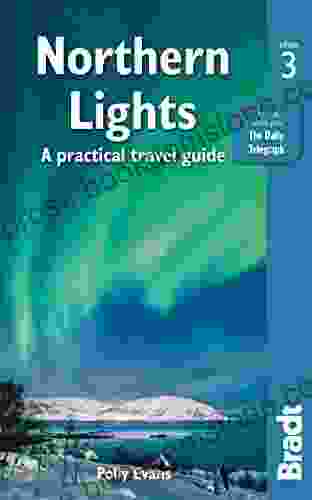
 George R.R. MartinNorthern Lights: A Comprehensive Guide to Witnessing the Aurora Borealis
George R.R. MartinNorthern Lights: A Comprehensive Guide to Witnessing the Aurora Borealis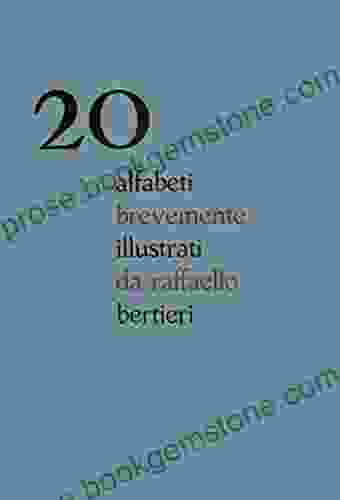
 Jace Mitchell20 Alfabeti Brevemente Illustrati Da Raffaello Bertieri: A Journey into the...
Jace Mitchell20 Alfabeti Brevemente Illustrati Da Raffaello Bertieri: A Journey into the... Lord ByronFollow ·8.2k
Lord ByronFollow ·8.2k Isaac MitchellFollow ·2.9k
Isaac MitchellFollow ·2.9k Dan HendersonFollow ·11.1k
Dan HendersonFollow ·11.1k Alvin BellFollow ·16.2k
Alvin BellFollow ·16.2k Ruben CoxFollow ·13k
Ruben CoxFollow ·13k Henry HayesFollow ·7k
Henry HayesFollow ·7k Paulo CoelhoFollow ·4.2k
Paulo CoelhoFollow ·4.2k Craig BlairFollow ·14.2k
Craig BlairFollow ·14.2k

 Tony Carter
Tony CarterEgypt's Years of Revolution: A Journey Through Tumultuous...
Egypt, a nation steeped in...
4.8 out of 5
| Language | : | English |
| File size | : | 37051 KB |
| Text-to-Speech | : | Enabled |
| Screen Reader | : | Supported |
| Enhanced typesetting | : | Enabled |
| X-Ray | : | Enabled |
| Word Wise | : | Enabled |
| Print length | : | 220 pages |
| Lending | : | Enabled |


